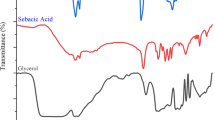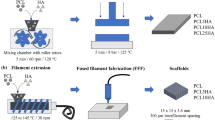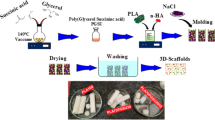Abstract
Porous bioresorbable polymers have been widely used as scaffolds in tissue engineering. Most of the bioresorbable scaffolds are aliphatic polyesters and the methods employed to prepare the porous morphology may vary. This work describes and evaluates the in vitro degradation of porous and dense scaffolds of poly(ε-caprolactone) (PCL) and poly(d,l-lactic acid-co-glycolic acid) (50/50) (PLGA50) prepared by particulate leaching-melt compression process. Biological evaluation was carried out using osteoblast cell cultures. The results showed an autocatalytic effect on the dense samples. Osteoblasts presented intermediate adhesion and the cell morphology on the surface of these materials was dispersed, which indicated a good interaction of the cells with the surface and the material.








Similar content being viewed by others
References
Gloria A, De Santis R, Ambrosio L. Polymer-based composite scaffolds for tissue engineering. J Appl Biomater Biomech. 2010;8(2):57–67.
Vert M. Degradable and bioresorbable polymers in surgery and in pharmacology: beliefs and facts. J Mater Sci Mater Med. 2009;20(2):437–46.
Kretlow JD, Klouda L, Mikos AG. Injectable matrices and scaffolds for drug delivery in tissue engineering. Adv Drug Deliv Rev. 2007;59(4–5):263–73.
Barbanti SH, Santos AR Jr, Zavaglia CAC, Duek EAR. Porous and dense poly(l-lactic acid) and poly(d,l-lactic acid-co-glycolic acid) scaffolds: in vitro degradation in culture medium and osteoblasts culture. J Mater Sci Mater Med. 2004;15:1315–21.
Mooney DJ, Baldwin DF, Suh NP, Vacanti JP, Langer R. Novel approach to fabricate porous sponges of poly(d,l-lactic-co-glycolic acid) without the use of organic solvents. Biomaterials. 1996;17:1417–22.
Eldsäter C, Erlandsson B, Renstad R, Albertsson AC, Karlsson S. The biodegradation of amorphous and crystalline regions in film-blown poly(ε-caprolactone). Polymer. 2000;41:1297–304.
Murakami N, Fukuchi S, Takeuchi K, Hori T, Shibamoto S, Ito F. Antagonistic regulation of cell migration by epidermal growth factor and glucocorticoid in human gastric carcinoma cells. J Cell Physiol. 1998;176(1):127–37.
Eglin D, Alini M. Degradable polymeric materials for osteosynthesis: tutorial. Eur Cell Mater. 2008;16:80–91.
Li S. Hydrolytic degradation characteristics of aliphatic polyesters derived from lactic and glycolic acids. J Biomed Mater Res. 1999;48:342–53.
Widmer MS, Gupta PK, Lu L, Meszlenyi RK, Evans GRD, Brandt K, Savel T, Gurlek A, Patrick CW, Mikos AG. Manufacture of porous biodegradable polymer conduits by an extrusion process for guided tissue regeneration. Biomaterials. 1998;19:1945–55.
Mikos A, Temenoff J. Formation of highly porous biodegradable scaffolds for tissue engineering. Electron J Biotechnol. 2000;3:114–9. http://www.ejbiotechnology.info/index.php/ejbiotechnology/article/view/427. Accessed 24 June 2011.
Plikk P, Målberg S, Albertsson AC. Design of resorbable porous tubular copolyester scaffolds for use in nerve regeneration. Biomacromolecules. 2009;10(5):1259–64.
Duek EAR, Zavaglia CAC, Belangero WD. In vitro study of poly(lactic acid) pin degradation. Polymer. 1999;40:6465–73.
Wu L, Jing D, Ding J. A “room-temperature” injection molding/particulate leaching approach for fabrication of biodegradable three-dimensional porous scaffolds. Biomaterials. 2006;27(2):185–91.
Penco M, Sartore L, Bignotti F, D’antone S, Landro L. Thermal properties of a new class of block copolymers based on segments of poly(d,l-lactic-glycolic acid) and poly(ε-caprolactone). J European Polym. 2000;36:901–8.
Pietrzak WS, Sarver DR, Verstynen ML. Bioabsorbable polymer science for the practicing surgeon. J Craniofac Surg. 1997;8(2):87–91.
Kim JY, Yoon JJ, Park EK, Kim DS, Kim SY, Cho DW. Cell adhesion and proliferation evaluation of SFF-based biodegradable scaffolds fabricated using a multi-head deposition system. Biofabrication. 2009;1(1):015002.
Ren J, Zhao P, Ren T, Gu S, Pan K. Poly (d,l-lactide)/nano-hydroxyapatite composite scaffolds for bone tissue engineering and biocompatibility evaluation. J Mater Sci Mater Med. 2008;19(3):1075–82.
Santos AR Jr, Barbanti SH, Duek EAR, Dolder H, Wada RS, Wada MLF. Vero cell growth and differentiation on poly(l-lactic acid) membranes of different pore diameters. Artif Organs. 2001;25:7–13.
Moreira PL, An YH, Santos AR Jr, Genari SC. In vitro analysis of anionic collagen scaffolds for bone repair. J Biomed Mater Res B Appl Biomater. 2004;15:229–37.
Lombello CB, Santos AR Jr, Malmonge SM, Barbanti SH, Wada MLF, Duek EAR. Adhesion and morphology of fibroblastic cells cultured on different polymeric biomaterials. J Mater Sci Mater Med. 2002;13:867–74.
van Eijk F, Saris DB, Creemers LB, Riesle J, Willems WJ, van Blitterswijk CA, Verbout AJ, Dhert WJ. The effect of timing of mechanical stimulation on proliferation and differentiation of goat bone marrow stem cells cultured on braided PLGA scaffolds. Tissue Eng. 2008;14(8):1425–33.
Bessa PC, Casal M, Reis RL. Bone morphogenetic proteins in tissue engineering: the road from laboratory to clinic, part II (BMP delivery). J Tissue Eng Regen Med. 2008;2(2–3):81–96.
Acknowledgments
This work was supported by the Brazilian National Council for Scientific and Technological Development (CNPq) (Grant 141582).
Author information
Authors and Affiliations
Corresponding author
Rights and permissions
About this article
Cite this article
Barbanti, S.H., Santos, A.R., Zavaglia, C.A.C. et al. Poly(ε-caprolactone) and poly(d,l-lactic acid-co-glycolic acid) scaffolds used in bone tissue engineering prepared by melt compression–particulate leaching method. J Mater Sci: Mater Med 22, 2377 (2011). https://doi.org/10.1007/s10856-011-4398-0
Received:
Accepted:
Published:
DOI: https://doi.org/10.1007/s10856-011-4398-0




